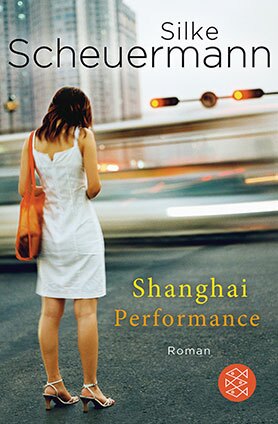Silke Scheuermann
Shanghai Performance
[Shanghai Performance]
- Schöffling & Co.
- Frankfurt am Main 2011
- ISBN 978-3-89561-373-9
- 312 Pages
- Publisher’s contact details
Silke Scheuermann
Shanghai Performance
[Shanghai Performance]
This book was showcased during the special focus on Spanish: Argentina (2009 - 2011).
Sample translations
Review
This city is gigantic. More than twenty-three million inhabitants throng through the canyons between Shanghai's skyscrapers, on a surface more than seven times that of Berlin. In 2008, the author Silke Scheuermann was also there for two months, and was inspired to write a novel whose very title bears its name: Shanghai Performance. And this Chinese port city is indeed more than the backdrop of the action – it plays one of the lead roles.
Luisa, the first-person narrator, a Ph.D. in art history, looks back on her experiences in Shanghai with the distance of a few years. Originally a Black Forest native, she works in Frankfurt as assistant to a high-profile performance artist, Margot Winkraft. She enjoys life in the hip art scene, flies with her boss to Sydney, Paris, L.A., and turns down no experience that comes her way. At some point her boy-friend, who is waiting at home for her, has enough. He breaks up with Luisa after her fling with a Californian surfer dude. For Luisa, reeling from the experience of being dumped, the offer to organise a performance in Shanghai with Margot comes as a welcome distraction from her lovesickness. It is the summer of the Olympic Games.
The attractive Luisa drifts through the hot, muggy city in the estuary of the Yangtse River. She enjoys the countless impressions bombarding her, strolls over the Bund, the long waterside promenade on the western bank of the Huangpu River. Silke Scheuermann succeeds admirably at conveying Shanghai's special atmosphere to the reader. Steaming food aromas mingled with the commotion of the streets alternate with cool hotel bars. Trendy gallery neighbourhoods such as the M 50 Art Quarter and parties high above the city contrast with still temples and the West Lake, two hours by car from the metropolis. Many of the places she describes exist in fact, among them the "Old China Hand Reading Room" and the "Vienna Café."
The performance with the title "Arbeiter und Träumer" (i.e. workers and dreamers) is only a means to an end. On the one hand for the artist, who narrates an impressive story about guilt, various women's roles and a female artist's egocentrism. On the other for Margot Winkraft, who lays out her art project solely as a lure for her daughter, who lives in Shanghai. Although Luisa notices that her idol is behaving oddly, she once again distracts herself from her thoughts with an affair. Ultimately, the tragic ending of someone's life throws all involved off of their respective tracks. And Luisa is forced to realise that although Margot Winkraft may well be an important artist, as a human being she revolves only around herself, coolly and calculatingly exploiting others.
Two things strike one about Silke Scheuermann's novel: the overwhelming effect that Shanghai must have had on her, and her enthusiasm for contemporary Chinese art. Even if the spatial scenarios of Vanessa Beecroft and Spencer Tunick may well have served as models for Winkraft's performance – 23 practically naked women standing for hours on a heap of earth – it is apparent that for the author the Chinese artists are the more exciting ones. Yang Zhichao from Beijing, for instance, who has objects surgically implanted in his body or has grass planted on his back. At the same time, Scheuermann casts a satirical light on the superficial self-involvement of the art world – with pop-cultural allusions to "Dr. House," "Belle & Sebastian" and Pierce Brosnan. But above all, she seeks answers to the old question: just how important should art be?
Along the way, she succeeds at writing something like a travel novel about the city on the South China Sea. With great local familiarity, she guides her readers through Shanghai's amazing diversity, and also succeeds at describing the various perspectives of Europeans and North Americans on the Chinese way of life. How does one cope with the difficult language as a foreigner? How to deal with state censorship? And what is life like in a city that seems to be so much closer to the future than anything from yesterday? After reading this remarkable novel, one also realises: however exotic this mega-city may seem – basically, Shanghai has long since ceased to be a Chinese city and become a global one.

Luisa, the first-person narrator, a Ph.D. in art history, looks back on her experiences in Shanghai with the distance of a few years. Originally a Black Forest native, she works in Frankfurt as assistant to a high-profile performance artist, Margot Winkraft. She enjoys life in the hip art scene, flies with her boss to Sydney, Paris, L.A., and turns down no experience that comes her way. At some point her boy-friend, who is waiting at home for her, has enough. He breaks up with Luisa after her fling with a Californian surfer dude. For Luisa, reeling from the experience of being dumped, the offer to organise a performance in Shanghai with Margot comes as a welcome distraction from her lovesickness. It is the summer of the Olympic Games.
The attractive Luisa drifts through the hot, muggy city in the estuary of the Yangtse River. She enjoys the countless impressions bombarding her, strolls over the Bund, the long waterside promenade on the western bank of the Huangpu River. Silke Scheuermann succeeds admirably at conveying Shanghai's special atmosphere to the reader. Steaming food aromas mingled with the commotion of the streets alternate with cool hotel bars. Trendy gallery neighbourhoods such as the M 50 Art Quarter and parties high above the city contrast with still temples and the West Lake, two hours by car from the metropolis. Many of the places she describes exist in fact, among them the "Old China Hand Reading Room" and the "Vienna Café."
The performance with the title "Arbeiter und Träumer" (i.e. workers and dreamers) is only a means to an end. On the one hand for the artist, who narrates an impressive story about guilt, various women's roles and a female artist's egocentrism. On the other for Margot Winkraft, who lays out her art project solely as a lure for her daughter, who lives in Shanghai. Although Luisa notices that her idol is behaving oddly, she once again distracts herself from her thoughts with an affair. Ultimately, the tragic ending of someone's life throws all involved off of their respective tracks. And Luisa is forced to realise that although Margot Winkraft may well be an important artist, as a human being she revolves only around herself, coolly and calculatingly exploiting others.
Two things strike one about Silke Scheuermann's novel: the overwhelming effect that Shanghai must have had on her, and her enthusiasm for contemporary Chinese art. Even if the spatial scenarios of Vanessa Beecroft and Spencer Tunick may well have served as models for Winkraft's performance – 23 practically naked women standing for hours on a heap of earth – it is apparent that for the author the Chinese artists are the more exciting ones. Yang Zhichao from Beijing, for instance, who has objects surgically implanted in his body or has grass planted on his back. At the same time, Scheuermann casts a satirical light on the superficial self-involvement of the art world – with pop-cultural allusions to "Dr. House," "Belle & Sebastian" and Pierce Brosnan. But above all, she seeks answers to the old question: just how important should art be?
Along the way, she succeeds at writing something like a travel novel about the city on the South China Sea. With great local familiarity, she guides her readers through Shanghai's amazing diversity, and also succeeds at describing the various perspectives of Europeans and North Americans on the Chinese way of life. How does one cope with the difficult language as a foreigner? How to deal with state censorship? And what is life like in a city that seems to be so much closer to the future than anything from yesterday? After reading this remarkable novel, one also realises: however exotic this mega-city may seem – basically, Shanghai has long since ceased to be a Chinese city and become a global one.
Translated by Edith C. Watts

By Daniel Grinsted
Daniel Grinsted is a cultural critic with a degree in Anglo-American literature. He works as a freelance arts journalist for the Frankfurter Allgemeine Zeitung, Zeit Online, Literaturen, Börsenblatt and other media.
